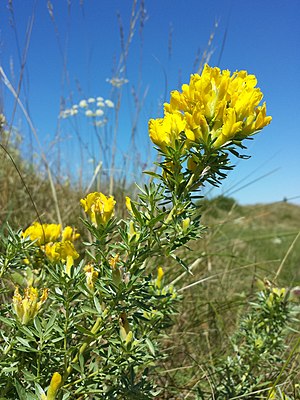Austria pygmy clover
| Austria pygmy clover | ||||||||||||
|---|---|---|---|---|---|---|---|---|---|---|---|---|

Austria pygmy clover ( Chamaecytisus austriacus ) |
||||||||||||
| Systematics | ||||||||||||
|
||||||||||||
| Scientific name | ||||||||||||
| Chamaecytisus austriacus | ||||||||||||
| ( L. ) Link |
The Austrian pygmy clover ( Chamaecytisus austriacus , syn .: Cytisus austriacus ), also called Austrian pygmy clover and Austrian pygmy gorse , is a plant species from the genus pygmy clover ( Chamaecytisus ) and belongs to the legume family (Fabaceae).
description
Vegetative characteristics
The Austrian pygmy clover is a perennial woody plant that usually reaches heights of 30 to 70 cm. The upright stem is closely covered with silver-gray hair. The screw- like leaves are stalked and triple-fingered. The entire-margined leaflets are closely covered with gray hairs underneath, from obovate-elliptical to lanceolate in shape and one to five times as long as they are wide. The terminal leaflet is hardly larger than the lateral leaflet.
Generative characteristics
The flowering time of the Austrian pygmy clover extends in Central Europe from June to October. The flowers are usually in pairs to eight in terminal, short racemes on the long shoots . The peduncle is at most half as long as the calyx . The flowers are zygomorphic , hermaphrodite butterfly flowers and shorter than 2 cm. The tubular cup is more than twice as long as it is wide. The yellow petals are free from each other. The flag is more or less densely hairy on the outside and without a dark spot. The shuttle is shorter than the flag and wing and otherwise bare eyelashes. There are ten stamens and a top constant ovaries with a slightly curved aufstrebend stylus with a scar present.
Chromosome number
The number of chromosomes is 2n = 48, 50 or 100.
ecology
The Austrian pygmy clover is a Chamaephyte . The species likes to grow over loess .
distribution
The species has its natural range in eastern Central Europe , in eastern and southeastern Europe as well as in western Asia and the Caucasus . In the German-speaking area , the species is indigenous only in Austria .
In Austria, the Austrian pygmy clover occurs only in the Pannonian area in the federal states of Vienna , Lower Austria , Burgenland and possibly in Upper Austria scattered or rarely on dry slopes and semi- arid grassland in the colline altitude . The species is considered endangered in Austria.
photos
Individual evidence
- ↑ a b c d e Manfred A. Fischer, Karl Oswald, Wolfgang Adler: Excursions flora for Austria, Liechtenstein and South Tyrol . 3rd, improved edition. Province of Upper Austria, Biology Center of the Upper Austrian State Museums, Linz 2008, ISBN 978-3-85474-187-9 , p. 569 .
- ↑ Chamaecytisus austriacus at Tropicos.org. In: IPCN Chromosome Reports . Missouri Botanical Garden, St. Louis
- ↑ The Euro + Med PlantBase - the information resource for Euro-Mediterranean plant diversity, accessed December 30, 2014
- ↑ Chamaecytisus austriacus in the Germplasm Resources Information Network (GRIN), USDA , ARS , National Genetic Resources Program. National Germplasm Resources Laboratory, Beltsville, Maryland.







